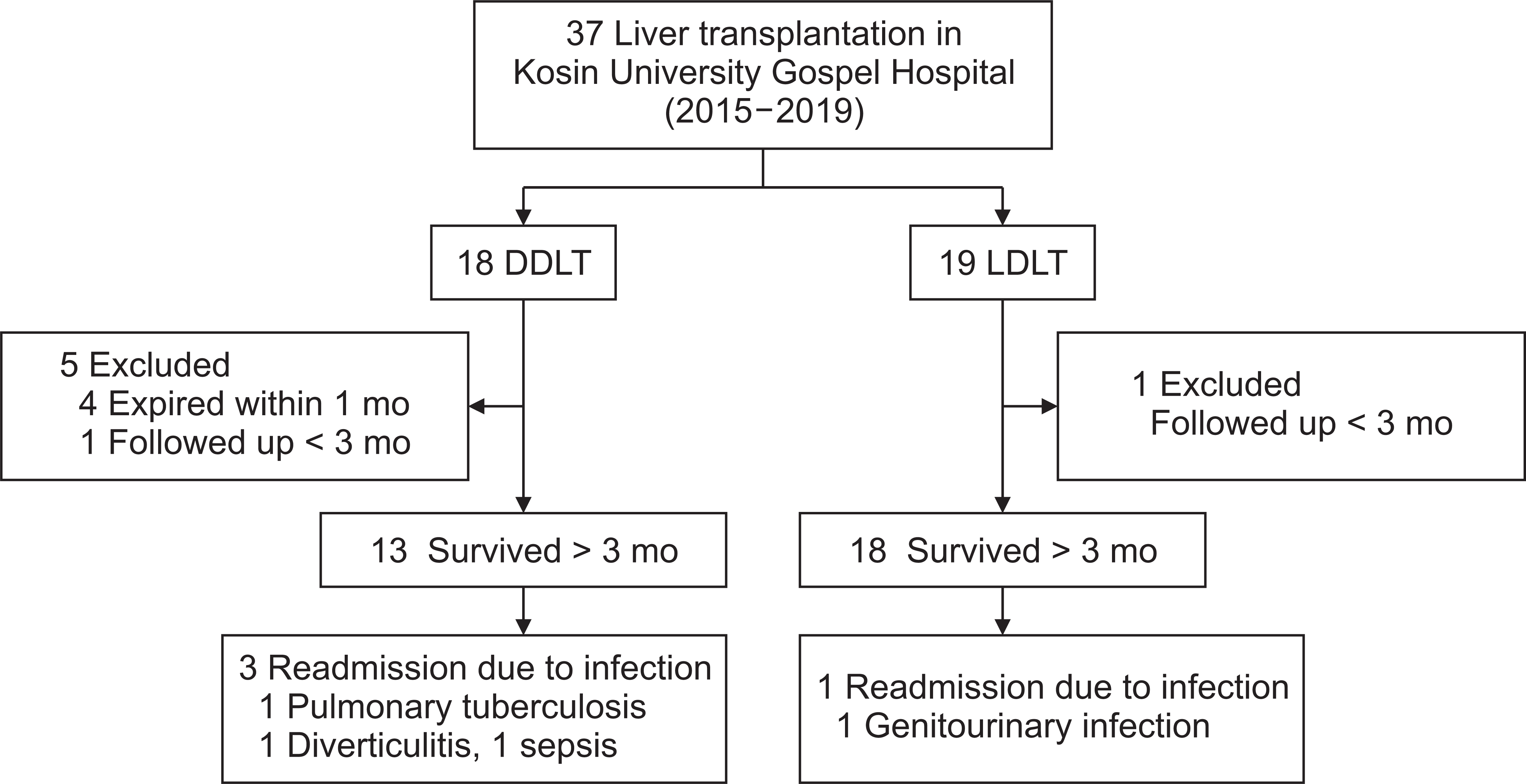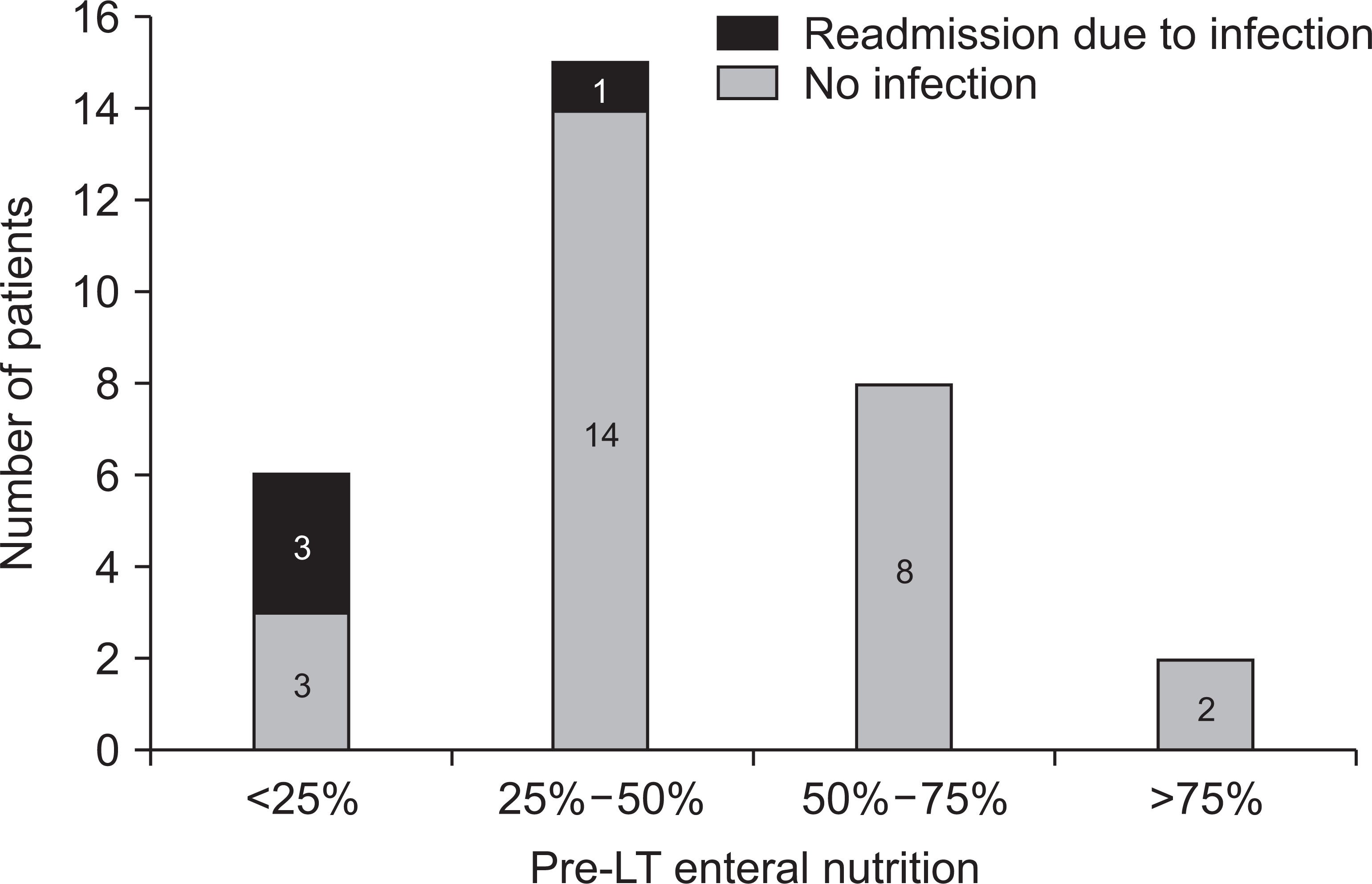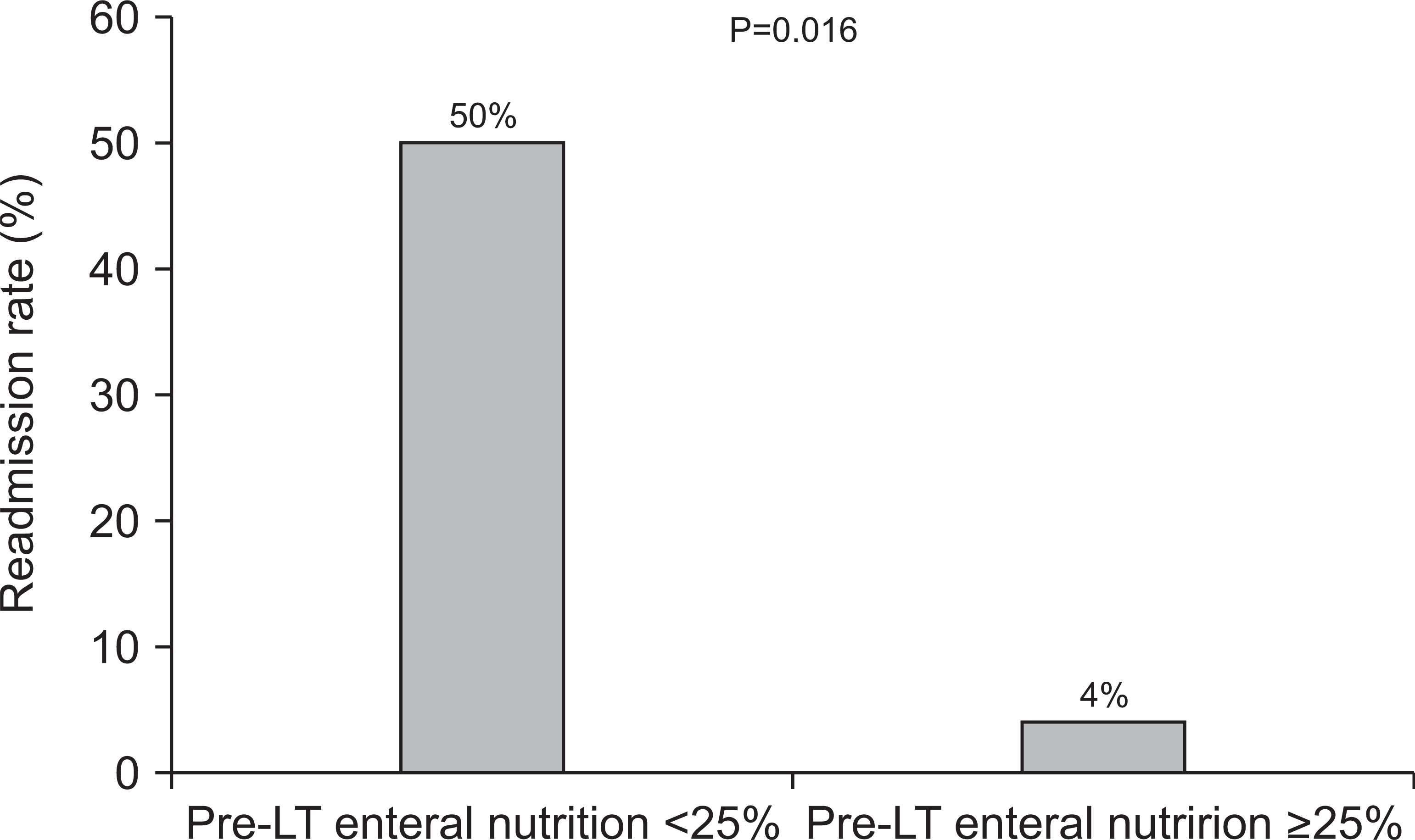INTRODUCTION
Protein energy malnutrition is a common clinical manifestation of patients with end-stage liver disease waiting for liver transplantation (LT) [
1], and it is a risk factor for morbidity and mortality after LT [
2]. The nutritional status of liver transplant recipients can deteriorate rapidly due to underlying malnutrition, surgical stress, immunosuppressive therapy, postintervention complications, postoperative protein metabolism, and pretransplant fasting periods [
3]. Resumption of oral nutrition within 12 hours after LT has been shown to reduce postoperative viral infection and maintain adequate nitrogen balance. Therefore, the transplant recipient should start to consume small amounts of oral nutrition after LT and gradually increase their amount according to their ability [
4]. However, there is little research on the clinical importance of enteral feeding before LT. The aim of this study is to investigate the effect of enteral feeding before surgery on clinical outcomes after LT.
METHODS
This study was approved by the Institutional Review Board/Ethics Committee of Kosin University Gospel Hospital (IRB No. KUGH 2019-09-019). Informed consent was waived because of the retrospective study design.
Study Population
From January 2015 to May 2019, the medical records of patients who underwent LT at Kosin University Gospel Hospital were retrospectively analyzed. A total of 37 patients underwent LT: 18 with deceased donor liver transplantation (DDLT) and 19 with living donor liver transplantation (LDLT). Liver recipients who survived for more than 3 months after transplantation were defined as subjects of this study. In the DDLT group, four patients died within 1 month after LT. Forty-seven-year-old male recipient died at 25 days after LT due to graft failure. The amount of enteral nutrition (EN) before LT was poor (EN <25%). Fifty-seven-year-old male recipient died at 23 days after transplantation due to acute rejection (EN 25%–50%). Sixty-year-old male recipient died at 4 days after LT due to graft failure caused by vascular complication (EN 50%–75%). Forty-year-old male recipient died at 31 days after transplantation due to graft failure (EN <25%). One patient in DDLT group received transplantation within 1 month. In the LDLT group, only one patient received transplantation within 1 month. Consequently, 13 DDLT patients and 18 LDLT patients, for a total of 31 patients, were analyzed in this study (
Fig. 1).
Nutritional Status
We estimated skeletal muscle mass as an objective nutritional measure of patients with advanced liver cirrhosis. Since it is practically impossible to estimate a patient’s total skeletal muscle, we used the psoas-muscle index (PMI), which is known to be highly correlated with total skeletal muscle mass. Patients’ PMI was measured via abdominal computed tomography (CT) within the month before LT. All abdominal CT images were analyzed using PACS (picture archiving and communication system). The cross-sectional area of the bilateral psoas on the axial plane was measured at the lower level of the third lumbar vertebra. PMI was obtained by summing the areas of both sides of the lumbar vertebrae at the third lumbar spine on CT and patients’ squared heights were standardized (cm2/m2). The ImageJ program developed at the National Institutes of Health (Bethesda, MD, USA) was used to measure the psoas muscle area.
Enteral Nutrition Assessment
The liver transplant waiting list is typically assessed by a nutritionist in our transplantation center before transplant. Clinical dietitians interviewed the patients and evaluated their oral intake for 2 weeks before LT. Patients’ enteral nutritional status was divided into four categories: <25%, 25%–50% 50%–75%, and >75% of target nutritional intake. Target nutritional intake was defined by European Association for the Study of the Liver (EASL) Clinical Practice Guidelines on nutrition in chronic liver disease [
5]: >30 kcal/kg/day for preoperative cirrhotic patients. After LT, the enteral nutritional intake of patients was evaluated by our transplantation center’s nurses who specialize in LT. The post-LT enteral nutritional intake level was divided into: poor (<30%), moderate (30%–60%), and good (>60%).
Clinical Outcome of LT
To evaluate clinical outcomes after LT, we analyzed the duration of intensive care unit (ICU) stay, mechanical ventilatory care and total admission duration after LT. From the time of LT, we evaluated initiation and amount of EN intake. Importantly, we also reviewed patients’ rehospitalization frequency due to infection, cause of infection and treatment progress from their medical records.
Statistical Analysis
Means, and standard deviations were calculated for all continuous variables, and an independent t-test was performed to compare means between transplantation type (DDLT and LDLT) groups. Categorical variables were expressed as percentages and the chi-square test was used to compare patient groups. Multivariate logistic regression analyses were performed to identify risk factors for rehospitalization due to infection. Statistical significance was determined at P<0.05, and IBM SPSS ver. 21.0 (IBM Corp., Armonk, NY, USA) was used for all analyses.
DISCUSSION
It is well known that pre-transplantation baseline nutritional status affects LT clinical outcomes. Pretransplant nutritional status can be evaluated with a range of objective tools, including BMI, and serum albumin, as well as by a subjective global assessment. However, the accuracy of these methods is poor in LT patients. The most objective nutritional assessment method for advanced liver-disease patients is skeletal muscle mass [
6]. The reduction of skeletal muscle mass, defined as sarcopenia, is objectively reflected in the nutritional status of patients with advanced liver disease. Moreover, sarcopenia is not only a marker of nutritional status before LT, it is also the most important prognostic factor after LT [
7,
8]. The index that most correlates with total skeletal muscle mass is L3-level muscle mass [
9], which is the most widely used objective nutritional assessment method for measuring the psoas muscle area on CT or magnetic resonance imaging, after adjusting for height [
6].
It is also well known that pretransplantation and posttransplant nutrition have a significant impact on LT outcome. A previous study showed that early enteral feeding within 12 hours after LT reduced infection complications. Although it did not directly affect survival, it was found that bacterial infection was reduced, confirming the benefit of early enteral feeding after LT [
10]. Another study reported that after LT, EN with immunomodulating diets could reduce bacteremia incidence [
11].
These studies have motivated transplantation hospitals to accept the importance of posttransplant EN. With respect to this study, our transplantation center started EN at an early stage, regardless of transplant type; thus, there was no statistical difference between the two groups (P=0.165). Additionally, it has been reported that perioperative nutritional therapy improved survival after LT in patients with sarcopenia, which is considered a marker of poor nutritional status [
12]. The average psoas-muscle index of patients in our study was low; most of the patients had malnutrition. Therefore, they were more sensitive to nutritional supply.
Several other studies have identified the importance of pre- and posttransplantation nutritional supply for liver-disease patients. In a small number of patients, pre-transplantation immunonutrition supply was found to improve pretransplantation nutritional status, improve posttransplantation recovery, and reduce posttransplant complications [
13]. Infection is one of the most serious complications that can occur in liver-transplant patients, and can increase mortality [
14]. The colon is the organ with the most complex microbiome in the body. Therefore, the intestinal immune system and the mucosal barrier play an important role in protecting the body from bacterial infections [
15]. Consequently, dysbiosis of the intestines in advanced liver-disease patients is an important cause of systemic infection [
16]. Additionally, EN can increase the flow of bile, which prevents intestinal mucosal atrophy and consequently preserves intestinal structure and function [
15]. Based on these results, researchers conducted a study of continuous probiotics administration before and after LT. Continuous administration of probiotics before LT did not reduce mortality after surgery. However, they did observe that 30 days and 90 days after surgery, infection incidence was reduced. Additionally, liver function was recovered relatively early after transplantation [
17]. In other words, EN in liver-transplant patients determines intestine health, and the health of the intestine influences infection risk, which in turn shapes LT outcomes.
To our knowledge, this is the first report of the clinical significance of EN before LT in Korea. Through patient interviews, clinical nutritionists directly and objectively measured the amount of preoperative EN by comparing the guideline-recommended nutrients to each patient’s actual enteral nutritional intake [
5]. Clinical outcomes were different according to enteral nutritional supply. Liver transplant recipients who had less than 25% EN compared to the recommendation before transplantation were found to have higher readmission rates due to infection. Preoperative EN was found to independently affect the LT clinical course, regardless of preoperative nutritional status as assessed by PMI, LT type, and nutritional supply after LT.
This study had several limitations. First, our data are limited because this was a retrospective analysis of a single center. Second, it is difficult to generalize our findings because we had a small number of patients. Third, most recipients had a low psoas-muscle index and were suspected to have relatively poor nutritional status, which could be a confounding factor for our results. Nevertheless, this study yielded the important conclusion that pre-LT EN has clinical significance. In conclusion, patients who are preparing for LT should be encouraged to maintain adequate EN to reduce risk of infection and readmission after LT. In addition, severe liver-disease patients who are waiting for DDLT may be able to improve their LT clinical outcome by acquiring EN even through a feeding tube.







 PDF
PDF Citation
Citation Print
Print



 XML Download
XML Download